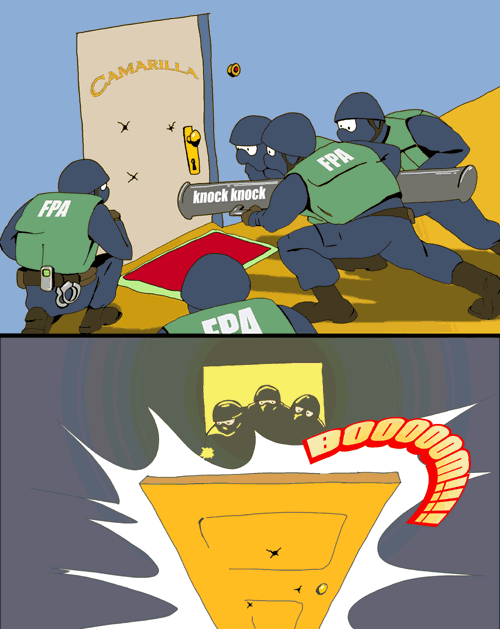Part III. Other ways of Pivots calculation

Commander in Pips: At the end of discussion Pivot points, let’s talk about other ways of their calculation. These ways are not widespread and not integrated into most trading software, although possibly you’ll find some that have it. Here I will not show you any chart, because I also have no software to demonstrate them. Still – they look absolutely the same, the difference only is that these pivots have a bit different level than common Pivots.
In general, the major difference of this alternative calculation way is twofold – either to give more weight to closing price, or to combine pivots with Fib ratios. You will see it clearly, when we point out the formulas.

Pipruit: And maybe we will skip it? Why we need them at all?
 AsstModerator Note: I think I was at that party. :)
AsstModerator Note: I think I was at that party. :) 
Let’s start from so called Woodie Pivot Points:
WOODIE PIVOTS
R2 = PP+H-L;
R1 = 2xPP-L;
PP = (H+L+2C)/4
or sometimes it calculates as
(Previous H+ previous L + 2 Current Open)/4
S1 = 2xPP-H
S2 = PP-H+L
R1 = 2xPP-L;
PP = (H+L+2C)/4
or sometimes it calculates as
(Previous H+ previous L + 2 Current Open)/4
S1 = 2xPP-H
S2 = PP-H+L
As you can see the major difference is that Woodie pivots give more weight to close price than to others prices – as high, as low. We know that classical pivots calculate based on the previous trading session H, L and C prices. But Woodie pivot points could use Open price of current trading session instead of close price of previous trading session. Although on Forex they are quite the same – on other markets they could be significantly different. The major reason for dominating of close price is that it’s extremely important in technical analysis and serves for estimation of numerous crucial moments – for instance, close above/below some support/resistance, MA etc. That’s why close price so important in technical analysis, and that’s why Woodie Pivots give it greater weight in calculation.
CAMARILLA PIVOT POINTS
Name Camarilla means a group of confidential, often scheming advisers; a cabal (Spanish, diminutive of cámara, room, from Late Latin camera) – here is the explanation of this word from inventor of these pivot equations Nick Stott:
“Everyone asks me that. When I first started trading, I thought (as a lot of people do!) that the markets were controlled by a secret 'insiders club' of powerful organizations who manipulated prices for their own benefit. I remember that at the time I was smugly sure that this was so, and was excited to be joining (as I then thought!) this secret 'cabal'. Of course, as I learned more about the markets, I realized that this was nonsense, and that the markets are far too big to be effectively controlled, even by gigantic financial corporations. However, it still looked to me as though there was a pattern in what was supposed to be the 'random walk', a pattern that matched very closely what I imagined a 'secret society' would try to implement in order to maximize their revenues. The obvious conclusion, of course is that if you have enough participants, statistically they start to behave in broadly predictable 'over-ways', and this leads to the patterning that the equation is so good at predicting. The word 'Camarilla' is based on the Latin word for room (camera), and it means basically a small clique of 'advisers' who try to manipulate the person in power for their own ends. Frankly, it was just a joke, and I am always surprised at how seriously everyone took it”.
This is just for information. But let’s discuss how to trade them, because they have a bit another using algorithm. Usually Camarilla Pivots are used for intraday trading and most importance has R3/S3 and R4/S4. R3 and S3 use for trading against the trend. If market finds resistance at R3 or Support at S3 and reverses back from these levels, despite the fact that the previous move was in the opposite direction – then you can enter against the trend with stop order near S4 and R4 and expecting some retracement. But if market breaks above R4 or below S4, then it tells that overall trend is strong and you should open position in the direction of trend. Of cause this is very simple explanation, but possibly it will be interesting for you and you can investigate Camarilla Pivots with more scrutiny.
Taking a look from a math standpoint on Camarilla pivots tells us that the major idea is the assumption that price gravitates to mean value, and in our case to Close price. As you can see in Support and Resistance calculation it does not use PP, but Close price instead. Anyway, these levels could be useful, some traders think that they even better than standard Pivots.
R4 = C + RANGE * 1.1/2
R3 = C + RANGE * 1.1/4
R2 = C + RANGE * 1.1/6
R1 = C + RANGE * 1.1/12
PP = (HIGH + LOW + CLOSE) / 3
S1 = C - RANGE * 1.1/12
S2 = C - RANGE * 1.1/6
S3 = C - RANGE * 1.1/4
S4 = C - RANGE * 1.1/2
RANGE = HIGH – LOW
FIBONACCI PIVOT POINTS
This approach is mixing of the classical pivot approach and camarilla approach. They use PP as classical one but also use multipliers as camarilla pivots, although these multipliers are Fib ratios:
Fibonacci Pivots attempt to combine Pivot algorithm and qualities with Fibonacci ratios. I do not know how they work or if they work at all, but here we show formulas, may be you will need them later.
Pipruit: Well, I’m a bit scared to ask it, but still what method is best?
Commander in Pips: And why are you scared?
Pipruit: Because of suspicion that I know your answer… “there is no single best method”, right?
Commander in Pips: Heh, sure. Let’s see. Different ways of calculation will give you different levels. As you understand many traders use different indicators and tools. For instance, somebody use MACD for trend estimation, other MA, and another one SAR etc. Hence, may be MACD better works with classical pivots, but MA better works with Camarilla, who knows? Also a lot will depend on criteria of trend shifting and other nuances. The point is that you should find those that will better work with your trading style and tools. That’s why there is no best method.
Another thought is – there were some reasons why some people, say Nick Stott has invented Camarilla Pivots, right? Hence he was not satisfied with standard pivots, but somebody else uses standard pivots and is absolutely happy. This is a question of suitability and trading style – all this stuff is very personal.
DeMark Pivot Points
So, here is the last way of Pivots calculation – personal way of Mr. Tom DeMark:
The formulas used in the calculation of the Tom DeMark "Pivot Points" are:
The value of X in the formula below depends on where the Close of the market is.
Well, this type is very specific – further to our conversation what type is better. Possibly they will be useful for you, particularly because they are specific and hardly spread enough amongst the traders, although Tom DeMark book “Technical analysis – New science” is a bestseller and there he spoke about these levels.
R3 = C + RANGE * 1.1/4
R2 = C + RANGE * 1.1/6
R1 = C + RANGE * 1.1/12
PP = (HIGH + LOW + CLOSE) / 3
S1 = C - RANGE * 1.1/12
S2 = C - RANGE * 1.1/6
S3 = C - RANGE * 1.1/4
S4 = C - RANGE * 1.1/2
RANGE = HIGH – LOW
FIBONACCI PIVOT POINTS
This approach is mixing of the classical pivot approach and camarilla approach. They use PP as classical one but also use multipliers as camarilla pivots, although these multipliers are Fib ratios:
R3 = PP + RANGE * 1.0
R2 = + RANGE * 0.618
R1 = PP + RANGE * 0.382
PP = (H + L + C) / 3
S1 = PP – RANGE * 0.382
S2 = PP – RANGE * x 0.618
S3 = PP – RANGE * 1.0
R2 = + RANGE * 0.618
R1 = PP + RANGE * 0.382
PP = (H + L + C) / 3
S1 = PP – RANGE * 0.382
S2 = PP – RANGE * x 0.618
S3 = PP – RANGE * 1.0
Fibonacci Pivots attempt to combine Pivot algorithm and qualities with Fibonacci ratios. I do not know how they work or if they work at all, but here we show formulas, may be you will need them later.
Pipruit: Well, I’m a bit scared to ask it, but still what method is best?
Commander in Pips: And why are you scared?
Pipruit: Because of suspicion that I know your answer… “there is no single best method”, right?
Commander in Pips: Heh, sure. Let’s see. Different ways of calculation will give you different levels. As you understand many traders use different indicators and tools. For instance, somebody use MACD for trend estimation, other MA, and another one SAR etc. Hence, may be MACD better works with classical pivots, but MA better works with Camarilla, who knows? Also a lot will depend on criteria of trend shifting and other nuances. The point is that you should find those that will better work with your trading style and tools. That’s why there is no best method.
Another thought is – there were some reasons why some people, say Nick Stott has invented Camarilla Pivots, right? Hence he was not satisfied with standard pivots, but somebody else uses standard pivots and is absolutely happy. This is a question of suitability and trading style – all this stuff is very personal.
DeMark Pivot Points
So, here is the last way of Pivots calculation – personal way of Mr. Tom DeMark:
The formulas used in the calculation of the Tom DeMark "Pivot Points" are:
The value of X in the formula below depends on where the Close of the market is.
If Close < Open then X = (H + (L * 2) + C)
If Close > Open then X = ((H * 2) + L + C)
If Close = Open then X = (H + L + (C * 2))
R1 = X / 2 – L
PP = X / 4 (this is not an official DeMark number but merely a reference point based on the calculation of X)
S1 = X / 2 - H
Where R1 is the upper Resistance level, PP is the Pivot Point, S1 is the lower support level.
If Close > Open then X = ((H * 2) + L + C)
If Close = Open then X = (H + L + (C * 2))
R1 = X / 2 – L
PP = X / 4 (this is not an official DeMark number but merely a reference point based on the calculation of X)
S1 = X / 2 - H
Where R1 is the upper Resistance level, PP is the Pivot Point, S1 is the lower support level.
Well, this type is very specific – further to our conversation what type is better. Possibly they will be useful for you, particularly because they are specific and hardly spread enough amongst the traders, although Tom DeMark book “Technical analysis – New science” is a bestseller and there he spoke about these levels.
Comments
Hamza Samiullah
6 years ago,
Registered user
Nice
O
One-fm
5 years ago,
Registered user
Thanks
Table of Contents
- Introduction
- FOREX - What is it ?
- Why FOREX?
- The structure of the FOREX market
- Trading sessions
- Where does the money come from in FOREX?
- Different types of market analysis
- Chart types
- Support and Resistance
-
Candlesticks – what are they?
- Part I. Candlesticks – what are they?
- Part II. How to interpret different candlesticks?
- Part III. Simple but fundamental and important patterns
- Part IV. Single Candlestick Patterns
- Part V. Double Deuce – dual candlestick patterns
- Part VI. Triple candlestick patterns
- Part VII - Summary: Japanese Candlesticks and Patterns Sheet
-
Mysterious Fibonacci
- Part I. Mysterious Fibonacci
- Part II. Fibonacci Retracement
- Part III. Advanced talks on Fibonacci Retracement
- Part IV. Sometimes Mr. Fibonacci could fail...really
- Part V. Combination of Fibonacci levels with other lines
- Part VI. Combination of Fibonacci levels with candle patterns
- Part VII. Fibonacci Extensions
- Part VIII. Advanced view on Fibonacci Extensions
- Part IX. Using Fibonacci for placing orders
- Part X. Fibonacci Summary
-
Introduction to Moving Averages
- Part I. Introduction to Moving Averages
- Part II. Simple Moving Average
- Part III. Exponential Moving Average
- Part IV. Which one is better – EMA or SMA?
- Part V. Using Moving Averages. Displaced MA
- Part VI. Trading moving averages crossover
- Part VII. Dynamic support and resistance
- Part VIII. Summary of Moving Averages
-
Bollinger Bands
- Part I. Bollinger Bands
- Part II. Moving Average Convergence Divergence - MACD
- Part III. Parabolic SAR - Stop And Reversal
- Part IV. Stochastic
- Part V. Relative Strength Index
- Part VI. Detrended Oscillator and Momentum Indicator
- Part VII. Average Directional Move Index – ADX
- Part VIII. Indicators: Tightening All Together
- Leading and Lagging Indicators
- Basic chart patterns
- Pivot points – description and calculation
- Elliot Wave Theory
- Intro to Harmonic Patterns
- Divergence Intro
- Harmonic Approach to Recognizing a Trend Day
- Intro to Breakouts and Fakeouts
- Again about Fundamental Analysis
- Cross Pair – What the Beast is That?
- Multiple Time Frame Intro
- Market Sentiment and COT report
- Dealing with the News
- Let's Start with Carry
- Let’s Meet with Dollar Index
- Intermarket Analysis - Commodities
- Trading Plan Framework – Common Thoughts
- A Bit More About Personality
- Mechanical Trading System Intro
- Tracking Your Performance
- Risk Management Framework
- A Bit More About Leverage
- Why Do We Need Stop-Loss Orders?
- Scaling of Position
- Intramarket Correlations
- Some Talk About Brokers
- Forex Scam - Money Managers
- Graduation!